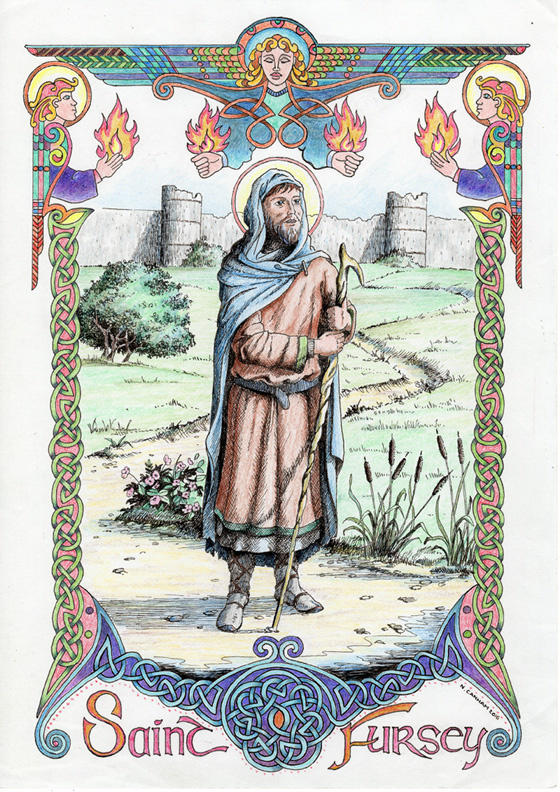
Image Source from AnaStpaul
Material below is distilled from Catholicireland.net and AnaStpaul and Catholic Encyclopaedia
Fursey (Fursa in Irish) was of noble Irish birth, born around 575. His name refers to virtue and Fursey became so, embracing religious life at the monastery of St. Meldan on the island of Inchquinn on the Lough Corrib, Co. Galway. He was an avid learner of spiritual writings and the practice of virtue from his youth.
Bede says of Fursey:
‘’There came out of Ireland a holy man called Fursa (Fursey), renowned both for his words and actions, and remarkable for his singular virtues, being desirous to live like a stranger for our Lord, wherever an opportunity should offer… he saw the angels chanting in heaven, and a vision of hell in which he saw four fires – the fire of falsehood, the fire of covetousness, the fire of discord and the fire of iniquity.’’
Bede also recounts in his Ecclesiastical History of the English nation, that St. Fursey went to East Anglia in 633 on a mission with at least four pilgrim companions, two brothers St Foillan and St Ultan, as well as two other priests called Dicul and Maeldubh. In East Anglia King Sigbert II received these pilgrims very well and gave them a tract of land for a monastery at Burgh Castle (Cnobbersburg), near present day Yarmouth. The King was so disposed because many years earlier found himself exiled into Gaul, in France by his step father King Redwald. It was in Gaul, where Sigbert became a Christian under the guidance of St. Columbanus and his monks who where on their peregrinus pro Christo. Sigbert returned to East Anglia in 631 and ascended the throne a new man; King Sigbert II. Now Fursey and company stayed at their newly founded monastery in East Anglia. They followed the Celtic liturgical tradition, which was an unusual occurrence in England.
Later King Anna, succeeded King Sigbert II, and St. Fursey was afforded further support, in evangelising East Anglia. The two other pilgrim priest, Dicul and Maeldubh went on to found monasteries elsewhere… Dicul evangelised the South Saxons, founding a monastery at Bosham, near Chichester. Maeldubh founded a monastery at Malmsbury in Wessex.
After about 12 years in East Anglia, Fursey and some monks departed to the Frankish kingdom of Neustria. St. Foillan was left in charge of the Norfolk monastery in East Anglia, while St. Ultan travelled with St. Fursey to Gaul. They met French king Clovis II ( 636-657) who authorised Fursey to establish a monastery near Paris at Lagny-sur-Marne in the region of Neustria (648). Fursey was given protection by Echinoald, Mayor of the palace of Clovis II.
St. Fursey was on another pilgrimage, this time to Rome, and stopped at the church of Mont-des-Cygnes in Mezerolles, dedicated to the apostles Peter & Paul. In this church Fursey deposited the sacred relics of St. Patrick as well as St. Meldan, his former Abbot in Galway. After his trip to Rome, he stayed awhile at Pérrone. He planned to go back to East Anglia. On his way there, he stopped again at Mezerolles, to stay a short time. But feeling ill, he remained there and soon died.
His body reposed for a time in that same church of Mont-des-Cygnes. His body was later translated to Péronne, where we get the name Perrona Scottorum (Péronne of the Irish). For this was the place offered to him by King Clovis through his mayor, Echinoald. Fursey’s tomb at Perrona Scottorum became an important pilgrim shrine and the monastery became a centre for the Irish. Ultan the brother of Fursey became the first abbot of this centre. St. Fursey’s body was interred two times to be placed in a tomb more fitting to his legacy, and his body was found to be incorrupt.
St. Fursey died around 650 A.D. and is remembered on the 16th January